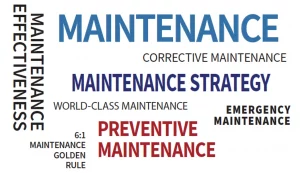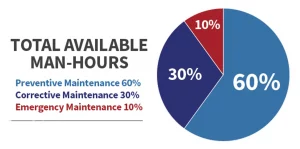Battle of the Work Types: Key Maintenance Terms
Robert Brieck, DPSI
Terminology used by maintenance departments produce a wealth of information when performing an Internet search. World-class maintenance status, cost benefits of preventive maintenance vs. corrective maintenance, 6:1 maintenance golden rule and maintenance effectiveness are just a few examples. As you scan through search results for maintenance terms such as these, you’ll come across professional articles, opinions, exercises and infinite calls to action inviting searchers to contact an organization for additional information. You will likely find guarantees to improve your maintenance operations and overall bottom line by following recommendations. However, what you likely won’t find is a clear-cut understanding of the differences between these maintenance terms due to a lack of consistency among sources.
Key Maintenance Terms
After reviewing various definitions of common maintenance terms, a relationship between preventive maintenance (PM), corrective maintenance (CM) and emergency maintenance (EM) work types is apparent. The vast array of articles written on these topics suggest percentage values for man-hours dedicated to PM, CM and EM based on total man-hours available within maintenance operations. These values range from between 50 and 85 percent for PM, 20 and 70 percent for CM, and five and 30 percent for EM.
The broad ranges listed in Figure 2 are indicative of widely separated values by work type, which suggests the industry authors of these articles do not differ significantly on their opinions of what constitutes a well-run department. They do, however, lead one to believe an organization is world-class or at least managed sufficiently based on these values. The problem is an inconsistency between definitions of various work types.
For example, take the following definitions from the online BusinessDictionary:
- PREVENTIVE MAINTENANCE – Systematic inspection, detection, correction and prevention of incipient failures before they become actual or major failures;
- CORRECTIVE MAINTENANCE – Activities undertaken to detect, isolate and rectify a fault so the failed equipment, machine, or system can be restored to its normal operable status;
- EMERGENCY MAINTENANCE – Sudden, unexpected, or impending situations that may cause injury, loss of life, damage to property and/or interference with the normal activities of a person or firm and, therefore, require immediate attention and remedial action.

While these definitions appear to create a sound relationship between the varying maintenance tactics, many industry authors deviate throughout their explanations. “Corrective maintenance identifies and corrects a maintenance fault after it has occurred,” according to one source.1 Additionally, “Corrective maintenance is the act of performing some repair or adjustment for a condition that was identified during the accomplishment of a PM or PdM (predictive maintenance) evolution, and cannot reasonably be corrected within the allowed labor time for accomplishing the PM or PdM,” says another source.2 Furthermore, “Corrective maintenance is the set of tasks destined to correct the defects to be found in the different equipment and that are communicated to the maintenance department by users of the same equipment,” says yet another source.3
Each Organization is Unique
Between organizations, there are vastly different definitions of PM, CM and EM. While they are not wrong, their interpretations aren’t uniform—at times within their own organization or departments. Definitions of work types and how those work types are applied to work orders can influence an organization as a whole. These definitions reflect on maintenance management tasks, including scheduling, work order completion and overall equipment effectiveness (OEE). Activities such as these indicate man-hours expended versus man-hours available displayed in reports as key performance indicators (KPIs) for the department.
Sources with varying definitions of PM, CM and EM often suggest that a specific percentage by work types, levels, or balance between those work types reflects a well-managed department and organization. Regardless of industry or organizational type, the ideal level or balance for each maintenance department is unique. It should be closely aligned with an organization’s mission statement and should be defined only by that individual department or organization.
As far as the overall premise of measurement concepts offered in the various sources mentioned, many of their ideas and values should be embraced. In fact, organizations are encouraged to consider these definitions at times. However, the ideal level or balance point among PM, CM, EM and other work types should:
- Account for the assets or equipment available for use in production when scheduled and for the entire scheduled production period;
- Apply to assets or equipment operating according to intended specifications and speeds, within the design and tolerance outputs, and at the production throughput quantity;
- Cover all expenses associated with those assets, including the maintenance department’s expenses.

A Uniform Approach?
Each organization needs to clearly define and record its own, unique meaning associated with each work type to eliminate any potential misunderstandings.
Most computerized maintenance management system (CMMS) software solutions allow users to enter this type of information, such as in a comment field. It would be extremely beneficial for an organization, such as the International Facility Management Association (IFMA), APPA: Leadership in Educational Facilities, or perhaps another relevant group to publish consistent definitions of terms used by maintenance departments. Undertaking an effort of this magnitude would provide an industry standard for the term, world-class maintenance. Consistent definitions for PM, CM, EM and others would certainly provide unification for maintenance departments across the board, regardless of sector.
In conclusion, the following advice is offered to organizations:
- Discuss the need for work types with all stakeholders, not just the production department, maintenance employees, or upper management.
- Obtain a consensus on work types and what each work type umbrella covers.
Only after following these key pieces of advice can an organization adequately generate, monitor and report against those agreed upon work types. Performing the correct work at the correct time allows the productive use of assets when needed, which leads to cost saving opportunities.
References
1. Life Cycle Engineering, Inc. Analyzing the Relationship of Preventive Maintenance to Corrective Maintenance.https://www.lce.com/Analyzing-the-Relationship-of-Preventive-Maintenance-to-Corrective-Maintenance-1091.html
2. Measure Twice. “Cost-Benefit of Preventive Maintenance vs. Corrective Maintenance.” Preventive Maintenance Tips: January 19, 2017. http://preventivemaintenancetips.com/preventive-maintenance-cost-benefit/
3. Garrido, Santiago Garcia. “Types of Maintenance.” PetrochemicalMaintenance.com.

Robert Brieck
Robert Brieck, is a professional services consultant for DPSI, a CMMS software company. Robert has over 40 years of experience as a senior level maintenance administrator at a number of organizations, most recently with the Community College of Allegheny County.
Related Articles

How to Fix the 70/30 Phenomenon

Zen and the Art of Managing Maintenance

Why do maintenance improvement initiatives fail to deliver? (Hedgehog or Fox?)

Why Maintenance Improvement Efforts Fail

TPM and RCM: Whirled Class

Where Do Maintenance Professionals Come From?




